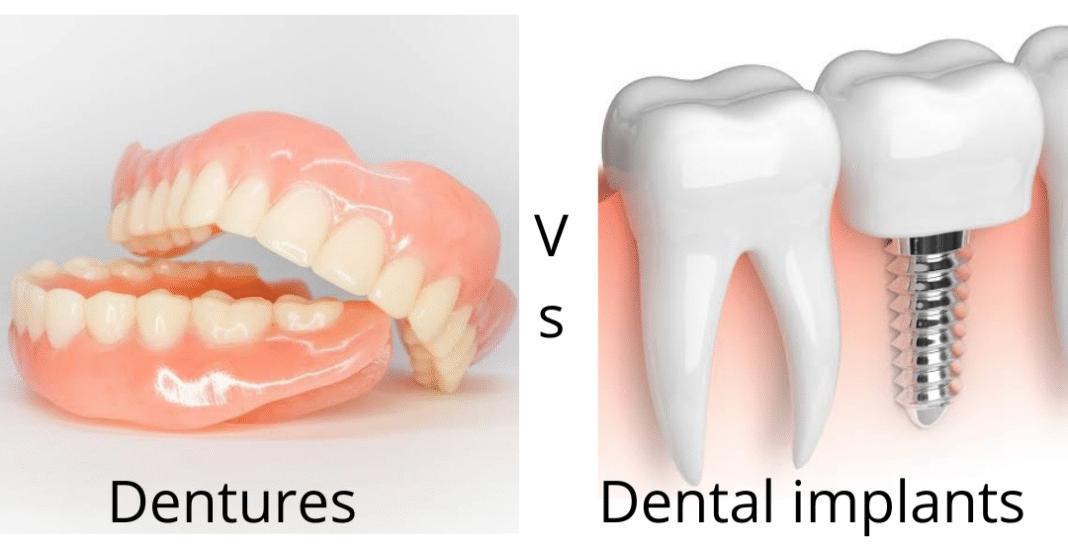Choosing a tooth replacement option is about daily comfort, confidence, and function. Implant dentures and traditional dentures both restore appearance and chewing ability, yet they differ in stability, care, and long-term value. This guide compares the two so you can discuss a plan with a Dentist and feel prepared to decide.
What are traditional dentures?
Traditional dentures are removable appliances that rest on the gums. They are custom shaped for your mouth and rely on suction on the upper arch and a mix of suction and muscle coordination on the lower arch. Modern materials can look natural and feel comfortable once you adapt. Because they sit on soft tissue rather than anchoring to bone, some people notice movement during eating or speaking, especially in the lower jaw.
Pros
- Usually, the quickest and least expensive way to replace many missing teeth
- Non-surgical and widely available
- Can be relined or adjusted as your mouth changes
Considerations
- May loosen over time as the jawbone remodels
- Adhesives are sometimes needed for confidence
- Chewing power is limited compared with fixed options
What are implant dentures?
Implant dentures, also called implant supported or implant retained dentures, connect to dental implants placed in the jawbone. The implants act like artificial roots that fuse with bone. The denture then attaches with snaps, a bar, or a fixed design that the dental team removes for maintenance. For a deeper look at planning, candidacy, and care, this dentist in Thornton answers common FAQs about Implant Dentures on their site.
Pros
- Greater stability for eating and speaking
- Less rubbing and fewer sore spots since implants support the denture
- Helps slow bone loss by stimulating the jaw during chewing
Considerations
- Requires surgery and healing time
- Higher upfront cost than traditional dentures
- Healthy gums and adequate bone are important for success
Comfort and stability in daily life
Comfort is closely tied to stability. Traditional dentures rely on a close fit to the gums and the way your cheeks and tongue help hold them in place. Many people adapt well, yet lower dentures can move during meals or conversation. Implant dentures anchor to the jaw and tend to feel more like natural teeth.
Chewing and diet
Traditional dentures often work best with a soft to medium texture diet. Certain foods like nuts, crusty bread, or steak can be challenging. Implant dentures increase chewing efficiency by transferring forces to the implants instead of compressing the gums. Many people find they can broaden their menu and spend less time cutting foods into very small pieces. A Dentist in Thornton, Co can set realistic expectations based on how many implants are used and how the denture is designed.
Bone health and facial support
When teeth are missing, the jawbone gradually resorbs because it is no longer stimulated by chewing forces. Traditional dentures do not slow this process, so they may feel looser over the years and need periodic relines. Implants stimulate the surrounding bone and help support facial contours, which can improve long term fit and appearance. This benefit is often most noticeable in the lower jaw.
Speech and appearance
Both options can look natural when crafted carefully. Speech tends to improve as stability improves. Traditional dentures may require a short practice period for certain sounds. With implant dentures, the added stability helps many people feel more confident speaking in social or professional settings.
Cleaning and daily maintenance
Traditional dentures are removed daily for cleaning with a soft brush and non-abrasive cleanser, then soaked overnight. Gums and tongue should also be brushed to keep tissues healthy.
Implant dentures require daily cleaning of the denture and the gums, plus attention to the implant connections. If the design is removable, you will take it out to clean around the implants. If it is fixed, your dental team will demonstrate techniques with floss threaders or small brushes. Regular checkups are important for both paths, and implant dentures include periodic checks of the implant components.
Treatment timeline
Traditional dentures can often be made within a few weeks once measurements and impressions are complete. Immediate dentures can be placed the same day teeth are removed, with later relines as tissues heal.
Implant dentures involve planning, surgery, and a healing period while implants integrate with bone. Many patients use a temporary denture during this time. Some cases allow earlier connection to implants, while others follow a staged schedule. Health history and bone quality guide the pace.
Cost and long-term value
Traditional dentures typically cost less at the start. Future relines and periodic remakes should be considered as the jaw changes. Implant dentures include surgical and restorative phases, which raises the initial investment. Many people see them as a long-term value because of improved function and stability. Coverage varies, so a review of benefits and payment options during consultation is useful.
Who might choose traditional dentures?
- You prefer a non-surgical solution
- You want the lowest upfront cost
- You are replacing teeth as a temporary step before a different treatment later
- Health or bone conditions make implants less suitable
Who might choose implant dentures?
- You want maximum stability for eating and speaking
- You would like to support bone and facial contours
- You are comfortable with a surgical plan and a longer timeline
- You prefer to minimize or eliminate denture adhesives
The best option is the one that fits your health, timeline, and daily goals. Start by listing what matters most to you, from food choices to cleaning routine to budget. If your priority is comfort and diet freedom, Implant Dentures may align with those goals. If you prefer a quicker non-surgical path, traditional dentures remain a dependable solution. A conversation with a dentist can help tailor a plan that matches your expectations and supports a confident smile for the long term.
